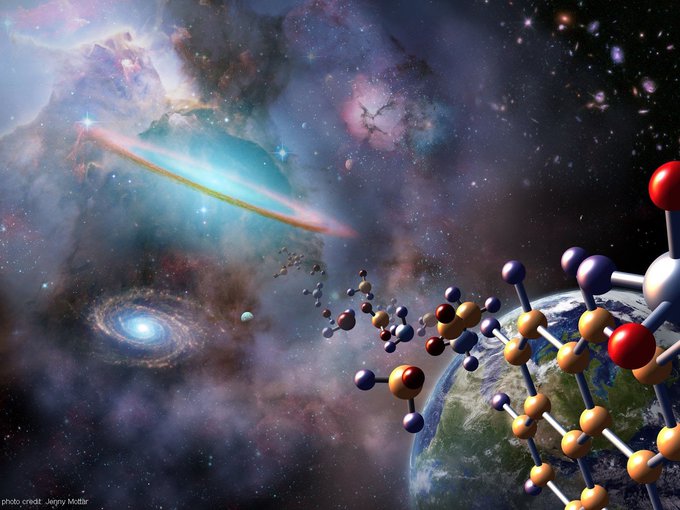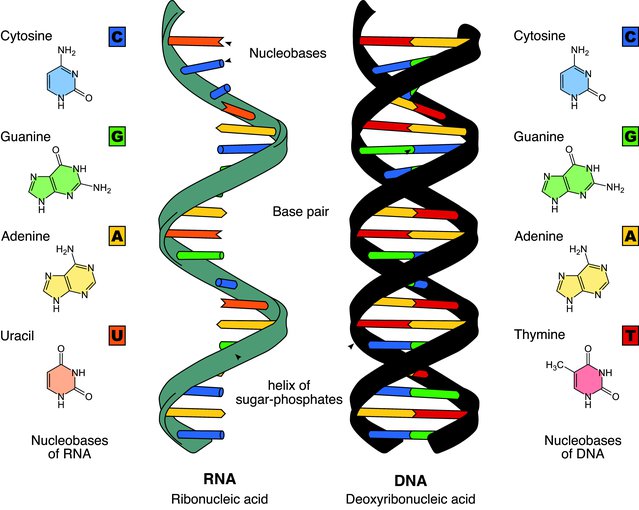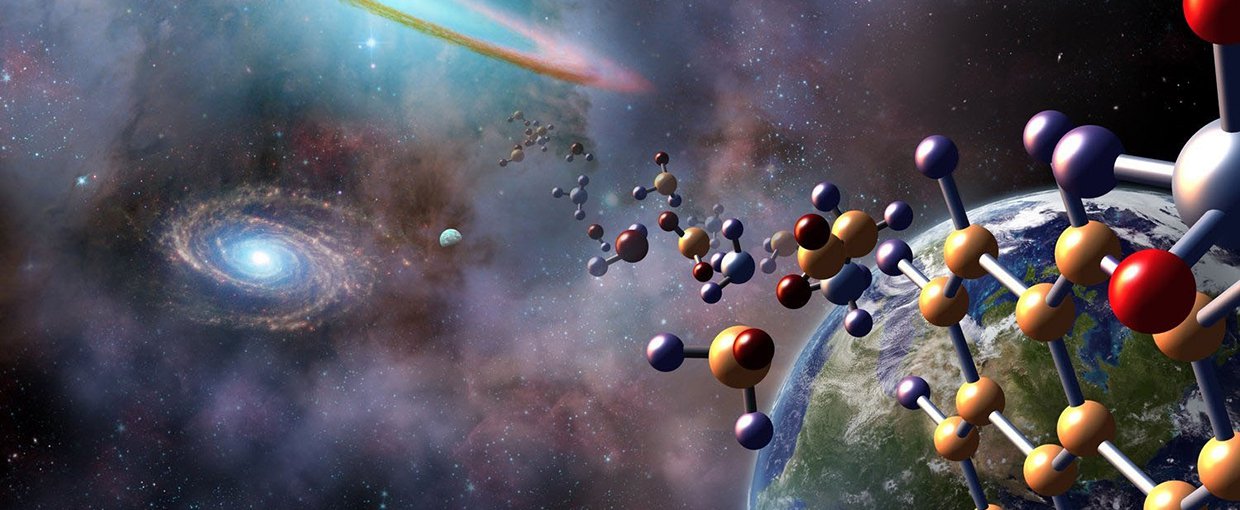Written byJoelle Renstrom

Researchers from the Georgia Institute of Technology may have made headway in helping determine the origin of life by identifying three different molecules that self-assemble to form a molecular structure with features characteristic of modern RNA.
RNA – or ribonucleic acid – carries out the instructions coded in DNA, but is also thought to have developed before DNA. Many scientists believe nucleic acids – the ‘NA’ of ‘RNA’ – played a key role in the origin of life. A popular theory called the ‘RNA World’ holds that RNA ‘invented’ proteins and eventually DNA, but that begs the question, where did RNA come from? Some believe a chemical or biological process gradually evolved an earlier molecule into RNA, while others chalk it up to some kind of non-enzymatic, geochemical reaction. It’s a chicken-or-egg debate: what biological process could produce a central building block for life itself? If the process wasn’t biological, then what was it and how did it happen?
The new study continues in the tradition of the 1953 Miller–Urey experiment, in which two scientists modeled early-Earth’s conditions with a mixture of gases and an electric current to simulate lightning. That experiment yielded amino acids, supporting the idea that biological molecules can spontaneously emerge from non-biological ones in the right circumstances. Despite that finding, the challenge of devising a scenario in which non-biological reactions create RNA has thus far proven insurmountable.

Which molecules formed RNA, and can we use them to identify where life may form in the Universe?Image credit: NASA/Jenny Mottar.
RNA’s origins lost in the mists of time
One of the study’s authors, biochemist Dr. Nicholas Hud, notes that the many criteria of RNA formation often means that when researchers propose a solution to one problem, a different problem (or two) arises. The links of the RNA chain, which are called nucleotides, are comprised of four bases: adenine (A), cytosine ©, guanine (G) and uracil (U), as well as a phosphate and a ribose sugar. Leslie Orgel, who was a pioneer of the RNA World idea, described the possibility that RNA evolved from an earlier molecule a “gloomy prospect,” as it would make solving the origin of RNA harder. The researchers decided it was time to face that challenge.
A re-analysis in 2008 of the Miller–Urey experiment reveals the production of far more non-biological molecules than previously thought, which underpins the authors’ hypothesis that molecules necessary for life existed on prebiotic Earth, but because they don’t play a major role in life as we now know it, we haven’t figured out which molecules or the roles they played all those billions of years ago.
According to Hud, those molecules were “probably very special because the molecules we know of don’t behave in ways that indicate they’re able to to start life.” Those molecules may also contain answers to other questions about life’s origins.
The evolution to RNA from an earlier genetic molecule, or proto-RNA, would have been incremental, and each new iteration would have been backward compatible, “like how an updated computer still has to be able to read files from older computers,” Hud tells Astrobiology Magazine. Today RNA and DNA use hydrogen-bonded base-pairs to transfer information. Thus, the molecules that don’t form the same or similar base-pairs wouldn’t have ever worked, leading the researchers to search for “base-pairing molecules that would self-select or segregate themselves on the early Earth into some kind of structure that would help them be incorporated into proto-RNA,” says Hud.
The search for the original molecules
What were those primordial molecules that formed the ancestor of RNA? To determine this, the researchers studied reactions in conditions that mimicked rain and evaporation cycles on the early Earth. After many unsuccessful experiments, they identified three molecular candidates for the bases of proto-RNA: barbituric acid,melamine, and 2, 4, 6-triaminopyrimidine. Reactions with these molecules and the ribose sugar produced nucleosides, which are composite molecules that are close to the sub-units of RNA.
Whereas previous attempts to join the current bases of RNA with ribose in early Earth reactions that were modeled either failed, or produced nucleosides in only very low yields, the researchers measured an 82% nucleoside yield with barbituric acid. Additionally, melamine and the triaminoprymidine molecules spontaneously formed nucleosides in over 50% yields. Dr. Niles Lehman, Professor of Chemistry at Portland State University and Editor-in-Chief of the Journal of Molecular Evolution, believes that the study “provides further support for the RNA World theory by providing a plausible series of events that took nature from chemical chaos to a more defined storage information molecule.”
That path isn’t completely clear, but it’s starting to take shape. According to Hud, their candidates for the ancestral bases of RNA are tantalizingly close to those of modern RNA. However, more needs to happen.
“The molecules we have identified look like they could have functioned in an early genetic system,” Hud says. “But we want molecules close enough that you can imagine an evolutionary path where they change into what we have today.” While demonstrable plausibility represents a step forward, the question remains whether it’s possible to find, and then confirm, the original proto-RNA molecules. Hud acknowledges that while the search might seem daunting, “chemistry is vast, but not infinite. If we accept a few reasonable assumptions about the ancestor of RNA, we can rule out a lot of possibilities. And maybe we can find it.” This study represents an important step down that path.

Side-by-side comparison of RNA and DNA for context.Image credit: Wikimedia Commons.
Origins of life elsewhere
Figuring out how RNA formed could help guide the search for extraterrestrial life. “We can gain valuable insight into key problems that need to be overcome for life to arise from non-life,” Lehman tells Astrobiology Magazine.
Understanding how life arises could help scientists determine where and how to look for life elsewhere. Amino acids and chemical compounds such as hydrogen cyanide, which has been detected in comets, could give rise to RNA bases, according to Hud. Such a reaction would be “robust, not strange or extraordinary,” he says. Similar processes could be underway on other planets and could point to the chemistry scientists should look for when searching for the earliest stages of life elsewhere.
The study, “Searching for Possible Ancestors of RNA: The Self-Assembly Hypothesis for the Origin of Proto-RNA,” was published in the journal Prebiotic Chemistry and Chemical Evolution of Nucleic Acids.
The work was supported by NASA Astrobiology through the Exobiology Program and the NSF/NASA Center for Chemical Evolution (CCE) at the Georgia Institute of Technology in Atlanta, Georgia. The CCE is a collaborative program supported by the National Science Foundation (NSF) and the NASA Astrobiology Program.
